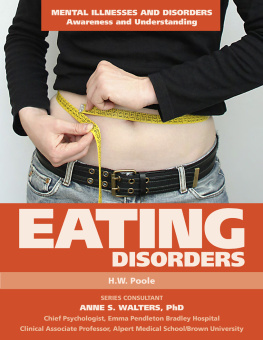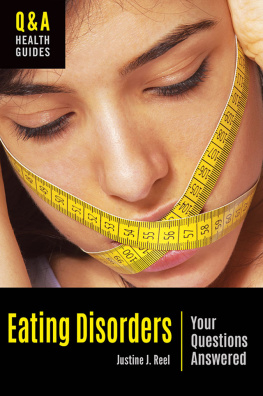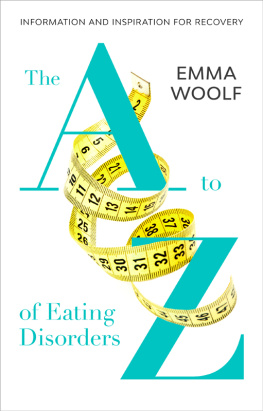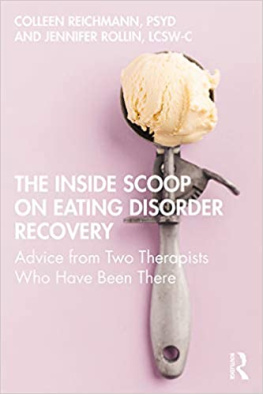2013 Gale, Cengage Learning
ALL RIGHTS RESERVED. No part of this work covered by the copyright herein may be reproduced, transmitted, stored, or used in any form or by any means graphic, electronic, or mechanical, including but not limited to photocopying, recording, scanning, digitizing, taping, Web distribution, information networks, or information storage and retrieval systems, except as permitted under Section 107 or 108 of the 1976 United States Copyright Act, without the prior written permission of the publisher.
Every effort has been made to trace the owners of copyrighted material.
LIBRARY OF CONGRESS CATALOGING-IN-PUBLICATION DATA
Hill, Jeff, 1962-Eating disorders / by Jeff Hill.
p. cm. -- (Nutrition and health)
Includes bibliographical references and index.
ISBN 978-1-4205-0719-5 (hardcover)
1. Eating disorders. 2. Eating disorders--Risk factors. 3. Eating disorders--Treatment. I. Title.
RC552.E18H533 2013
616.85'26--dc23
2012020004
Lucent Books
27500 Drake Rd.
Farmington Hills, MI 48331
ISBN-13: 978-1-4205-0719-5
ISBN-10: 1-4205-0719-2
Printed in the United States of America 1 2 3 4 5 6 7 16 15 14 13 12
TABLE OF CONTENTS
FOREWORD
M any people today are often amazed by the amount of nutrition and health information, often contradictory, that can be found in the media. Television, newspapers, and magazines bombard readers with the latest news and recommendations. Television news programs report on recent scientific studies. The healthy living sections of newspapers and magazines offer information and advice. In addition, electronic media such as websites, blogs, and forums post daily nutrition and health news and recommendations.
This constant stream of information can be confusing. The science behind nutrition and health is constantly evolving. Current research often leads to new ideas and insights. Many times, the latest nutrition studies and health recommendations contradict previous studies or traditional health advice. When the media reports these changes without giving context or explanations, consumers become confused. In a survey by the National Health Council, for example, 68 percent of participants agreed that when reporting medical and health news, the media often contradict themselves, so I dont know what to believe. In addition, the Food Marketing Institute reported that eight out of ten consumers thought it was likely that nutrition and health experts would have a completely different idea about what foods are healthy within five years. With so much contradictory information, people have difficulty deciding how to apply nutrition and health recommendations to their lives. Students find it difficult to find relevant, yet clear and credible information for reports.
Changing recommendations for antioxidant supplements are an example of how confusion can arise. In the 1990s antioxidants such as vitamins C and E and beta-carotene came to the publics attention. Scientists found that people who ate more antioxidant-rich foods had a lower risk of heart disease, cancer, vision loss, and other chronic conditions than those who ate lower amounts. Without waiting for more scientific study, the media and supplement companies quickly spread the word that antioxidants could help fight and prevent disease. They recommended that people take antioxidant supplements and eat fortified foods. When further scientific studies were completed, however, most did not support the initial recommendations. While naturally occurring antioxidants in fruits and vegetables may help prevent a variety of chronic diseases, little scientific evidence proved antioxidant supplements had the same effect. In fact, a study published in the November 2008 Journal of the American Medical Association found that supplemental vitamins A and C gave no more heart protection than a placebo. The studys results contradicted the widely publicized recommendation, leading to consumer confusion. This example highlights the importance of context for evaluating nutrition and health news. Understanding a topics scientific background, interpreting a studys findings, and evaluating news sources are critical skills that help reduce confusion.
Lucents Nutrition and Health series is designed to help young people sift through the mountain of confusing facts, opinions, and recommendations. Each book contains the most recent up-to-date information, synthesized and written so that students can understand and think critically about nutrition and health issues. Each volume of the series provides a balanced overview of todays hot-button nutrition and health issues while presenting the latest scientific findings and a discussion of issues surrounding the topic. The series provides young people with tools for evaluating conflicting and ever-changing ideas about nutrition and health. Clear narrative peppered with personal anecdotes, fully documented primary and secondary source quotes, informative sidebars, fact boxes, and statistics are all used to help readers understand these topics and how they affect their bodies and their lives. Each volume includes information about changes in trends over time, political controversies, and international perspectives. Full-color photographs and charts enhance all volumes in the series. The Nutrition and Health series is a valuable resource for young people to understand current topics and make informed choices for themselves.
INTRODUCTION
Mysterious and Misunderstood Illnesses
W hen anorexia nervosa was first identified as a distinct condition in the 1870s, descriptions of people who willingly starved themselves sometimes to the point of deathseemed strange and shocking. People had a very difficult time understanding a condition that defied one of the most basic human needs and desires: the consumption of food.
Today, eating disorders are no longer a novel subject. They are often discussed in the media and widely studied by doctors. The increased attention paid to eating disorders in the past half century has resulted in the identification of new conditions, including bulimia nervosa and binge-eating disorder. Despite all of these developments, though, eating disorders are still in many ways misunderstood.
The general public often views eating disorders in simple terms that distort the reality of what an affected individual experiences. Many people assume the disorders are merely diets that have gotten out of control, and that the behavior can be easily overcome by convincing or forcing the patient to eat. Other misconceptions are focused on common characteristics of individuals with eating disorders. Because they are frequently young and are obsessed with their weight, they are sometimes dismissed as vain and self-centered adolescents. Such opinions seem to suggest that an eating disorder is just a difficult phase that will end once the individual realizes that he or she needs to grow up. Moreover, media accounts often present the treatment process as a simple and relatively brief experience in which a patient completes a program and returns to normal life completely cured.














